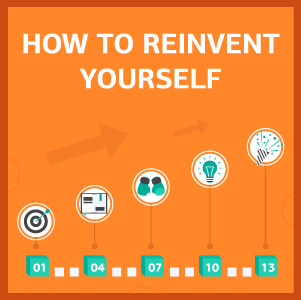
This step-by-step guide will show you how to reinvent yourself, and will have you on the road to the personal and professional reinvention you’ve been waiting for.
Sometimes life can get stale.
It feels like you’re spinning your wheels in the mud, and getting nowhere.
You reach a point at which you need to make a change. Whether that means shifting careers, making lifestyle changes, finding your passion in life, or reevaluating your relationships, you dream of a new self — the person you’ve always wanted to be.
That means it’s time to take stock of your life and work toward reinvention. Making a major change is tough. But it’s never too late, or too early, to do it.
Whether you are looking for a fresh start at 30, a new career at 40, or how to find your purpose at 60, there are concrete steps you can take to make it happen.
Regardless of who you are and where you are, you can’t ever hope to succeed if you don’t believe in yourself. If you’re fighting with self-doubt, try our mini-course Believing in Yourself. Discover powerful daily practices for remaining true to your values.
Find your starting point

In order to reinvent yourself, you first need to figure out who you are. The roles you perform for others, your career, your likes and dislikes — all of these create a patchwork for your identity.
Your quest toward reinvention begins with recognizing each piece of who you are. From here, you can see where you are in each area of your life. You can decide which pieces you want to keep, and which ones no longer serve you.
This can include identifying who you are as a friend, parent, leader, community member, and much more.
You will start to build new identities and be true to your authentic self as you move through this process — that is the essence of reinvention.
Acknowledge where you are now, compared to where you want to go. This is the starting point for your transformation.
Define your core values
What truly matters to you? Family, freedom, relationships, connection, career — these are all examples of core values. When you understand what matters to you, you can design a path toward a meaningful reinvention.
Think of your core values as your foundation. Just like the base of a home, your core values provide the groundwork for your decisions, actions, and behaviors. Without that sturdy foundation, your “home” just falls apart.
When you define your core values, you lay the foundation for the life you want. You will know the direction you need to take for reinvention. You’ll have an easier time making big decisions, and even knowing how to act in day-to-day situations. Over time, you will build a more meaningful life.
Open your mind to a shift in how you conceptualize selfhood. Following your inner “plumb line” of integrity and alignment with core values, you can imagine multiple possible selves.
Remember that your values and beliefs can shift over time. After all, what mattered to you the most at age 20 might not look the same at age 30, 40, or 50. Keep an open mind.
Clear space for reinvention

Too much going on at once can feel overwhelming, and end up keeping you from making any progress on your goals. If you really want to reinvent yourself, you need to develop mental focus and figure out how to prioritize your life.
Focus is the ability to place your attention on only one thing.
During this step, focus on clearing space in your life, and in your mind, for this reinvention process to take place. That means getting clear on your most important goals.
You can do this by observing some of your core values discovered during the previous step. Then make a connection between those values and actions needed to live them out.
You will need to free up time and energy for these important tasks, as well as rest and recovery.
Start keeping a reflective diary
Creating and using a reflective diary will help monitor your ongoing transformation and help you stay motivated as you make those big changes. Write down observations and keep track of progress along the way.
Journaling is also a great way to start noticing and changing your thoughts and behaviors. In order for reinvention to occur, you need to observe the way you think and the conversation that goes on inside your head.
When we think positively about ourselves, we carry ourselves with confidence. Self-confidence increases your chances of landing that dream job, approaching new people, or trying something outside of your comfort zone.
You’ll have an easier time with healthy communication styles and expressing yourself assertively to others.
But the same is true the other way around. Limited thought patterns can hold you back from living the life you want. If your thoughts loop with self-criticism, you restrict yourself from experimenting and making good decisions.
Do you often praise yourself often? Or, do you live in a constant stream of self-doubt? Use reflective journaling to note these thoughts, and work to replace them with more positive patterns.
Are Rigid Thought Patterns Distracting You and Disrupting Your Focus?
5 (proven) ways to uncover your deep thought patterns.
Grab our FREE cheat sheet today. Drop your email below.
Identifying your strengths
Knowing your strengths will propel you on the path to success, whether in your career or personal life.
Although we all have strengths, few have taken the time to identify what they are. So during this step, I’d like you to write down your skills and talents.
We have a full guide on the blog with lots of resources for identifying your strengths if you need guidance on this step.
Look at the characteristics and motivations that make you unique. When you put all those strengths into action, you can leverage them to build the life you want much faster.
Experiment with possible selves
When you start out your reinvention journey, you may have one idea of yourself: your core values, your goals, and your strengths. You’re in a great place to start building, but you don’t necessarily know which direction to take.
That’s why I encourage you to experiment with your life a bit. Learning how to reinvent yourself is a process of trying on different roles and experiences.
Try something new. Test the waters with a freelance job or a volunteer position. Take a chance on meeting someone who works in a field that interests you. Be curious.
Even if you feel uncomfortable, you’ll learn more about yourself and what you want out of life.
Keep track of these experiences in your reflective diary. Research how to apply what you’ve learned to new reinvention experiments.
We often put an unnecessary burden on ourselves as we play with experimental possible selves. It is disastrous to put that kind of burden on such fledgling adventures.
If you want to try something new, like exploring your hand at journalism by writing an op-ed, just go for it! Don’t spend the whole time asking destructive questions like, “How can I ever earn a living doing this?” or “How can I make this perfect?”
It is like asking a baby to pull us around in a wagon.
Give yourself the space to make mistakes. This isn’t about being perfect. It’s about learning and growing as you build the life of your dreams. That process isn’t linear, and you will likely go through twists, turns, and bumps on the road to reinvention.
Don’t expect every experiment to mean your next career. Allow them to show you the next stone to turn over or the next corner to go around.
Build courage through action

Making a big change can feel uncomfortable, scary, overwhelming — all those emotions fit.
Many may recognize their goal, but feel stunted by fear to take the next steps. People tend to get stuck within their comfort zones, like a self-made prison.
Courage means taking action, despite your fears.
That doesn’t mean you have to leap full force into your new life. Instead, start with small steps that bring you outside of your comfort zone bit by bit. As you move forward, these courage exercises can help identify and overcome your fears gradually.
Playing it safe won’t get you to your goal. If you want to make a major change, you’ll need to stick your neck out there. Reinventing yourself means taking risks in life.
That could mean attending a networking event, even if you feel shy. Maybe you always wanted to try a new sport or hobby. Apply to that dream job. You never know! While it may feel scary, life’s too short to stay stuck in your comfort zone. These small risks could lead to big opportunities.
Translating your identity into action brings your passions and aspirations into play. You begin to craft and execute a variety of reinvention experiments, while navigating the ambiguity that can come with personal development.
Begin a “100 Aspirations” List

What do you want out of life? Really?
You may have a rough idea of how to create the life you want. But when was the last time you sat down and asked yourself what you want to achieve in concrete terms?
Aspirations are the hopes and dreams that give meaning to your goals. They determine the next steps you need to take to make those dreams into a reality.
Seeing (in your mind) is believing (that it can happen).
Write down a list of 100 Aspirations. Get specific. When you have a clear vision, you will see the direction you need to go to achieve those reinvention goals. In fact, visualization increases your chances of success.
Widen your circle
Reinvention isn’t easy. But you don’t have to do it alone, and you shouldn’t.
As you learn how to reinvent yourself, having a strong support system will improve your chances of success.
Why your circle matters:
- Supportive friends and mentors can guide you through difficult situations and keep your goals in perspective.
- Role models and career coaches provide mentorship and resources in professional and personal development.
- Positive people lift you up and help you get back on track when things don’t go as planned.
So I encourage you to build a support circle. Let them know about your goals and challenges. A strong support system will help you move forward with your personal reinvention as you expand your professional network.
In addition to supportive friends, be sure to include role models and mentors in your circle.
Speaking to people who have already succeeded, you can get advice on how to make it happen, from people who have already done it.
When you learn what it takes, you can develop the habits of successful people. Look for people who have succeeded in a goal you want to achieve. Don’t be afraid to reach out to your role models to ask them for advice.
Widen your circles of influence and opportunity. You can learn from their experience, and implement those lessons in your own reinvention journey.
Keep learning
You have an immense amount of resources at your fingertips. Online, within your network, in books, through courses, you have endless opportunities to learn about the future you envision for yourself.
It’s time to use these resources to your advantage.
Do some research. Read. Join online communities. Attend conferences. Listen to TedTalks. Gain valuable advice from authoritative sources.
You can even craft a survey to gain market research from others about your business ideas or careers you want to explore.
Gain as much knowledge as you can to help you continue to grow and experiment with your new identities.
Bridge into the future

This step focuses on moving into a new professional identity.
After you’ve researched, networked, and made smaller experiments, you are ready to take a bigger step away from an old career identity, towards a new one.
You don’t need to find that dream job right away. It’s one thing to recognize that you want to leave your job, and a whole different ball game to know what to do next.
If you really feel miserable at your current position, or it leaves you no time and energy to pursue your reinvention goals, I suggest taking a bridge job.
A bridge job fills the gap between your current job and the career of your dreams. Sometimes, they just pay the bills. Or, it could mean volunteering after work, just to try something new.
Test different fields and industries. Continue to experiment with, and reflect on, your new identity. This way, you can learn through hands-on research and experimentation. You’ll also gain unique networking opportunities to further expand your career.
A bridge job is a transition — don’t get stuck there. Use it to play with ideas of reinvention to discover where you’d like to go next.
Bridge jobs can lead to where you want to be, as you continue to experiment with your new identity.
Staying the course
This step closes things off with a review of all of the relevant strategies you’ve learned along the way.
Take a look at your reflective diary and ask yourself:
- In which areas have you succeeded?
- What small victories have you had since you began your path to reinvention?
- What challenges have you faced along the way?
- What have you learned from those challenges?
- In which areas would you like to improve?
- Have any of your core values, strengths, and goals shifted along the way?
- Do you need to refocus your reinvention to new directions?
Self-assessment will help you reflect on progress. You can reevaluate your long term goals along the way. Continuous reflection helps you to avoid stagnation and continue moving forward on your reinvention.
Celebrate your success

Reinventing yourself takes time. When we set out to achieve those big goals, it doesn’t happen overnight. Take a look at those larger objectives.
Then consider the small steps you’ll need to take to achieve them. When you break down big goals into small, digestible chunks, you’ll have a better chance of success.
As you complete each small step, celebrate! Give yourself a pat on the back for all the hard work it took to get here. Providing rewards to yourself triggers a dopamine release in your brain, which helps maintain motivation until you’ve completed the reinvention process.
Making a BIG change isn’t easy. Are you ready, but not sure if you want to do it alone?
With more than 20 years of experience, we’ve been in the reinvention business.
Our Reinvention Rx course walks you through your reinvention journey, step by step, with all the tools you need and plenty of support to stay motivated along the way.
Are Rigid Thought Patterns Distracting You and Disrupting Your Focus?
5 (proven) ways to uncover your deep thought patterns.
Grab our FREE cheat sheet today. Drop your email below.

